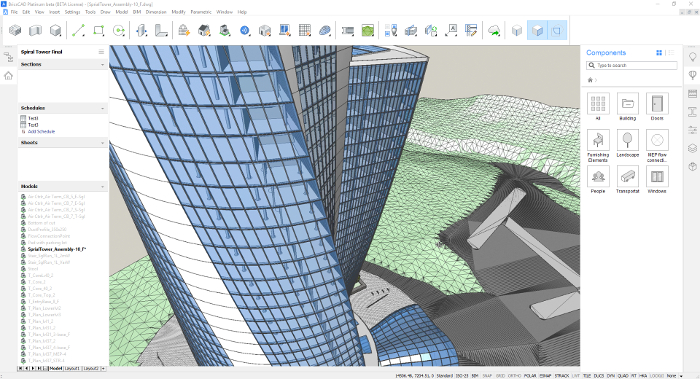Considering what a hot topic BIM has become, there have been very few new software firms willing to invest in creating new BIM authoring tools. This month we report on a new product, written on a ‘familiar’ package and backed by a huge company. Could BricsCAD BIM be the one to take on the might of Revit? By Martyn Day
It’s been 18 months since we last saw BricsCAD, from Ghent-based developer, Bricsys. The company started out developing an AutoCAD clone called BricsCAD and did a great job at creating a low-cost alternative to AutoCAD. Since then it has gone beyond AutoCAD and developed all sorts of original functionality to its base platform application. Although the company is dedicated to maintaining compatibility with DWG and AutoCAD, it wants to be perceived as a CAD developer in its own right and from what we saw at the firm’s recent London event, there is good reason.
Bricsys is not new to AEC or BIM. It developed TriForma which Bentley Systems sold as its core BIM application in the 1990s and then its own tool called Architecturals in the 2000s. The firm recently developed a SketchUp work-alike BricsCAD Shape. The company also develops tools for the manufacturing market with powerful parametric solid modelling (based on ACIS) and sheet metal applications.
AEC Magazine saw the company’s formative new BIM tools 18 months ago. The demonstration showed rectilinear ACIS solids being used to model a building and then the user applying IFC definitions post modelling. This turns products like Revit on their heads, as instead of using a palette of predefined and customisable objects to model with, like Lego, BricsCAD BIM was model first, then define. The benefit of this approach was that the conceptual phase didn’t require the architects to worry about object definitions, just define the forms.
This was all happening on top of BricsCAD, which is a DWG drawing and modelling tool which offers LISP, ARX and all the familiar AutoCAD functions you would expect. Bricsys thinks that those who have not yet made the move to Revit, may have more 2D processes and be happier doing their BIM modelling in a familiar environment, with the added advantage of it being cheaper. As things stood 18 months ago, however, the BIM functionality seemed all rather basic and there was evidently a long way to go.
A new owner
At last month’s Bricsys conference in London, the first big news was that the company had been acquired by Hexagon for an undisclosed sum. For those unfamiliar with Hexagon, it is a global giant of a firm, that operates in construction, engineering, mining, automotive and plant and has annual revenues in excess of £1.2 billion. It owns Leica, Intergraph, MSC Software, Z/I Imaging and many others.
While Bricsys had annual revenues of £13 million, now it is under the Hexagon umbrella it will have all the resources it could ever need, plus access to markets as a mature, trusted CAD platform. Hexagon also has a reputation of leaving the brands it buys alone to carry on developing semi-autonomously.
Hexagon previously ported its AutoCAD-based plant application, CADWorx Plant Design Suite, to Bricsys as an alternative for its customers to paying for Autodesk’s AutoCAD on subscription. Bricsys pricing is based on a perpetual licence and works on Windows, macOS and Linux. The entry-level BricsCAD is $825 forever; AutoCAD is $1,575 per year, LT is $390 per year. Bricsys also offers subscription at $312 per year, if that’s what you would prefer. Bricsys works out a lot cheaper than Autodesk Subscription for AutoCAD. Hexagon was perhaps the biggest thirdparty developer to realise that it could use the familiar APIs that AutoCAD has, to port its existing applications to BricsCAD and offer to save its customers money on their AutoCAD subscriptions.
BIM and development
What a difference 18 months makes. From seeing the initial BIM development work to what was presented on the stage in London was really quite a marked difference. While the concept is the same, the capability and ease of use really blew us away. At its core, you have a DWG compatible, and very capable, drawing platform. Bricsys has harnessed the ACIS solid modelling kernel to enable designers to create incredibly complex shapes, using booleans, workplanes, chamfers, surfaces, complex wireframe manipulation – the usual gamut of modelling tools.
Designers can create anything they can envision in geometry. So, now comes the real magic. Bricsys has utilised machine learning to start the process of turning these models into BIM. Using the ‘BIMify’ button, the software will analyse the model and turn the geometry it finds into rooms, floors, slabs, columns, walls, doors, windows – regular IFC components.
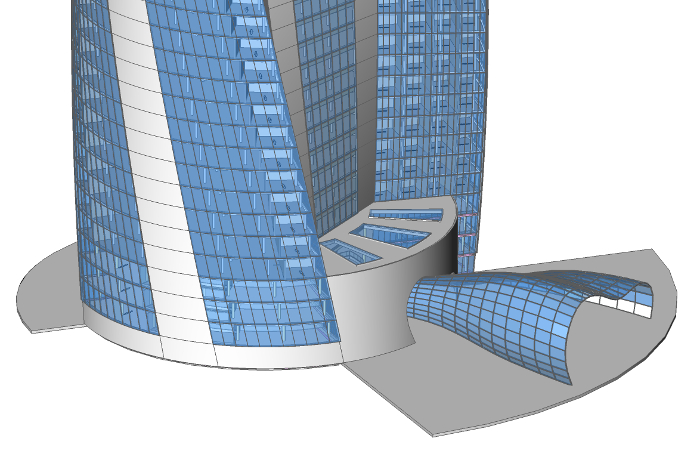
The user can then edit or add objects that the automation didn’t classify or omitted. This is seriously impressive and, unlike the first demo we had, it works well on some pretty crazy geometry. Zaha Hadid would have had some fun with this tool. This is a fantastic solution to the problem of linking conceptual modelling to the creation of BIM models, together with the added benefit of the backend processes such as drawing production being all in one package.
The curtain wall capability is also powerful; model your spline geometry, select face, create a grid and then dynamically manipulate to make traditional or freeform curtain walls. The software will generate all the frame elements, which of course can also be edited.
But as we all know, architecture is really only one component in the mix. Bricsys demonstrated some intelligent modelling of HVAC components within a BIM context. Automatic sizing and connections, together with some elementary auto complete capabilities gave a good indication of the way development was heading. Bricsys isn’t looking to deliver for the front end of the building process, but throughout all professions, including structural and site development (it even handles point clouds).

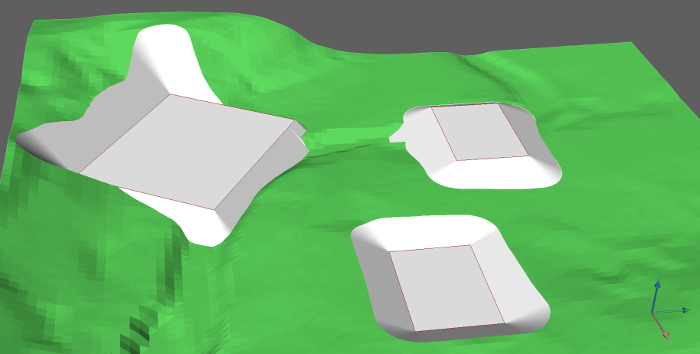
Because BricsCAD BIM is built on a DWG platform, it’s at this point that you really see the benefit in workflow vs something like Revit. We have lost count of the number of firms we have visited who take their Revit drawings into AutoCAD to finish off the documentation. This breaks with the BIM process as, if there are any changes, then the additional hours of drawing in AutoCAD need to be repeated. BricsCAD BIM is already inside its DWG documentation world and this destructive phase of using other tools than Revit can be avoided.
Speed was also very impressive. During the day’s talks all product demonstrations were done live from laptops. The underlying BricsCAD platform is a modern CAD product, it is fast, uses multiple cores and benefits from fast GPU graphics card accelerators. While one would assume that modelling architectural elements in full on solids over lightweight geometry would lead to hefty and unwieldy models, that certainly does not seem to be the case.
Parametrics are also built-in systemwide and can be used in a very intuitive fashion when designing. The ability to quickly model floors and partitions was fabulous and at all times the mouse and drawing lines give real-time feedback on relative geometry. Floors can be replicated in just a few clicks. In 2011, Bricsys acquired the intellectual property rights from Russian developer Ledas, which developed very high-end 2D/3D constraints tools and set up a technology division in Russia under Dmitry Ushakov. This move also enabled considerable advances for BricsCAD Platinum for Mechanical Design, which is aimed at the DS SolidWorks and Autodesk Inventors of this world.
Bricsys demonstrated something it calls A.I propagate, which uses artificial intelligence to replicate component details throughout a model. Simply select a component, plus the elements you want it to propagate over, and the computer does the rest. It also supports the import of RVT components, live building grids and ceilings. This can drastically speed up modelling. The user interface also really gives a clear indication of where the propagation of objects will take place.
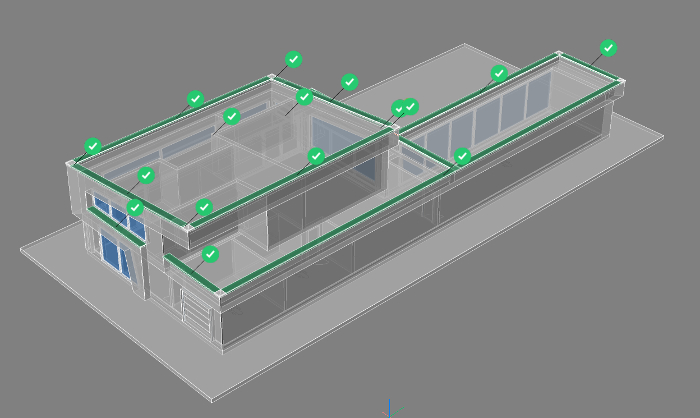
When at the documentation stage, BricsCAD has some fabulous capabilities for multi-view layout and for automating call-out details. Again, all in a DWG workflow and so common AutoCAD commands are used for drawing.
BricsCAD BIM is $2,275 a seat, for a perpetual licence with one year’s maintenance. Alternatively, it can be subscribed to for $910 a year. For comparison, Revit is currently $2,250 a year or $6,075 for a 3-year subscription.
2D CAD
BricsCAD started off life as an AutoCAD clone. The company then went on to develop functionality that you won’t find in AutoCAD. As Autodesk went off to develop or acquire other tools (Revit, Inventor, Fusion etc), the mentality that AutoCAD was the hammer that hit all nails disappeared. Bricsys is of the mentality that its DWG CAD platform can be extended to solve BIM, MCAD solid modelling and other verticals. In one respect at least, the persistence of drawings in our new 3D modelled world, would back this view up.
BricsCAD v19, the new version, will offer a range of powerful tools but we don’t have room to highlight them here. However, one feature that we did see is indicative of the kind of tools under development. We had seen BIMify; now there’s ‘Blockify’, huge models, 2D or 3D, measuring in the Gigabyte range, automatically turned into blocks, drastically reducing the file size. Again, machine learning at play; the software automatically detects equally shaped solids in a model and replaces them by block references and searches the drawing for an identical set of a 2D entities and replaces them by block references. Just look at AutoCAD 2019’s new feature set and wonder where the new features are, vs enhancements to existing ones.
24/7 collaboration
Not just content with developing products for every vertical market, Bricsys offers a cloud-based collaboration product called 24/7, which is free to customers on maintenance. It’s a global document management system for 2D drawings and 3D models, which supports multiple roles and access for defined users and has a graphical widget application development ability to automate repetitive tasks. The system has version control, activity logs and search capabilities. For BIM users it has a fast 3D data viewer, model annotation and DWG/ xref management.
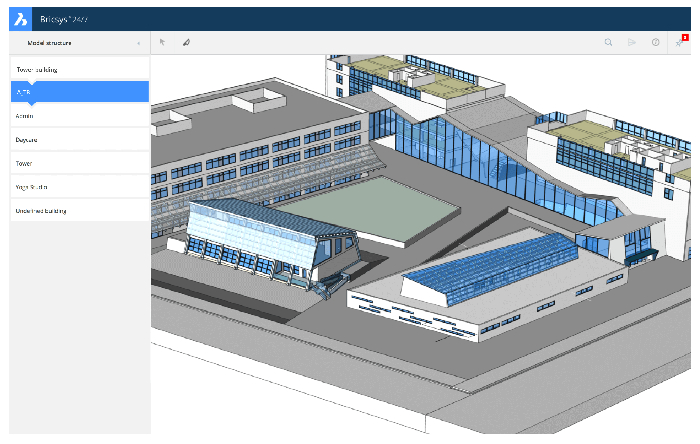
Management Q & A
Bricsys CEO, Erik de Keyser and Hexagon’s Rick Allen, PPM executive vice president answered questions on the surprise acquisition (this came as a shock to most Bricsys employers too). de Keyser explained that the driver for the acquisition was that being a great developer was not enough for success; marketing and sales required investment and as things stood, would have diverted R&D funds to enable that. Bricsys had been seeking investment and Hexagon had been interested since it ported its plant products to BricsCAD.
Allen explained that Hexagon was keen to offer customers a choice and with Autodesk’s pricing changes, subscription- only and potentially web-only products in the future, Bricsys would be there to offer an alternative. In the process of porting CADWorx to BricsCAD, Bricsys was incredibly responsive and over eight million lines of code were ported in nine months and the product is stable.
Allen, while predominantly dealing with the plant side of Hexagon’s business, sees the Bricsys acquisition as a play in all areas BIM, manufacturing, drafting, as well as plant. Allen identified that Revit, while popular in architecture, isn’t in other professions and they have picked up on a lot of end user dissatisfaction. While Hexagon will certainly focus on AutoCAD seats in its process plant customers, not just CADworx, Hexagon is looking at a much broader play.
De Keyser estimated that Revit had only hit 16% of BIM penetration of all the possible users and in certain geographies it was not the No.1 choice, with Vectorworks, Graphisoft and Allplan all occupying decent market share. de Keyser stated that with Hexagon behind them, Bricsys would aim for 20-25% of the market with the sales pitch being ‘you don’t need to leave DWG or translate to/from DWG. The workflow stays in one format as you move from application to application – at a fraction of the price. We will win one customer at a time.’
Looking forward, de Keyser stated that with IFC 4.0, it will become harder for firms, such as Autodesk, to trap customers in proprietary file formats, as substantially more of the data will be transferable.
While it’s the plant division of Hexagon that led the charge to acquire Bricsys, Allen made it clear that all divisions of Hexagon would have access to the technology and the buy-in was not simply cost justified on the benefit to the plant division. The company is taking aim at Autodesk and all players in BIM, mechanical, plant and drafting. With Autodesk dominating so many areas in the built space and with Autodesk Subscription increasing the cost of ownership, Hexagon is out to offer a lower cost alternative with enhanced functionality.
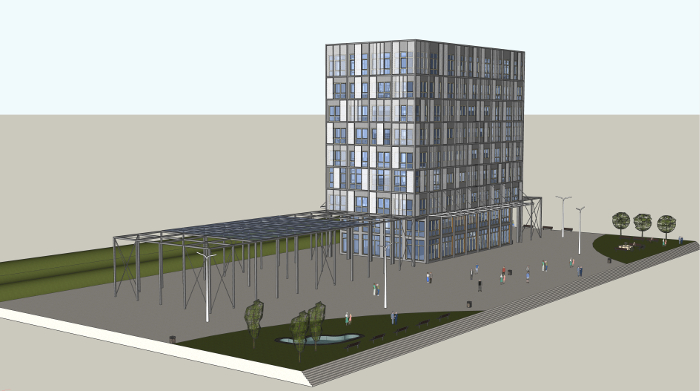
Conclusion
Many years ago, we watched Dominic Gallello, then Autodesk VP of Mechanical, launch Autodesk Inventor. This was a big deal for Autodesk as it was the first new code stream the company had delivered since AutoCAD decades before. At the time, Autodesk was trying to get into the 3D modelling market and had established players such as SolidWorks, Dassault Systèmes, Siemens, PTC etc. all with mature CAD products.
Gallello’s pitch was don’t judge us by the current feature set, judge us on the product’s ‘velocity’. Gallello was telling us the development team had new ideas to crack old problems and would be delivering on new functionality in a way the mature competition was not.
With BricsCAD BIM, we see that development velocity. In just 18 months the software has gone from being formative building modelling to offering something really different and innovative for BIM workflows. At the same time, it bashes you over the head as it’s all happening in an AutoCAD work-a-like, which is committed to supporting all the 2D processes millions of AutoCAD customers currently use.
We are in strange times. Autodesk’s move to Subscription without question increases costs to users in ownership over three years, compared to the traditional historic buy and upgrade cycles of around three years. Subscription does offer suites but that comes at a cost and not many utilise many of the products they get.
Autodesk’s channel is showing signs of rebellion, after years of deflating margins, with one or two now offering AutoCAD clones as alternatives to AutoCAD LT. This is a clear and present danger, as we estimate 40% of all Autodesk licences are AutoCAD LT. Revit’s development velocity has slowed and many are wondering when it will be re-written as the core is 20 years old. The conceptual side of BIM has never really been solved by anybody who can take that data on to be used throughout the design and documentation workflow.
Bricsys now has a giant backing it up. A giant that sees an opportunity in Autodesk’s base. Bricsys offers low-cost, AutoCAD functionality with perpetual licensing (or subscription), on multiple platforms, with unique BIM workflows, in a single environment, with machine learning cleverness, powerful MCAD part and assembly modelling, Autodesk APIs and even collaborative cloud-based management.
At the wrap up from the event, de Keyser took issue with the company being called a ‘clone developer’ by the press during that day’s tweets. He feels the development teams are now way beyond performing that work and are developing new functionality in all vertical areas. Even though the origins of the company are certainly defined by the work it has done on mimicking DWG functionality, it’s true that Bricsys is now defining a unique path. de Keyser quipped, “We are not a clone developer, we are a cyclone in the industry!”
For now, BricsCAD BIM is certainly something to watch. Revit has decades of development work put into it and I can’t see many switching like for like. However, with the velocity comes a trajectory and backed up with Hexagon, with a low price point, innovative machine learning development, this is a BIM product to watch. It’s the most promising modelling tool we have seen in BIM in the last ten years.
Next year will certainly be an interesting one in the BIM market. Hexagon has come to the table with Bricsys and a very impressive development team. We hear Dassault Systèmes has a construction BIM tool coming out. Siemens and Bentley continue to dance together and are working on many joint developments. Nemetscheck has a new Allplan and Vectorworks and Graphisoft are continuing to execute well. Things are hotting up and new and innovative solutions are still coming to the market. AEC Magazine will be here to keep you up to date.
Download a trial version of BricsCAD BIM at ■ bricsys.com/bim

If you enjoyed this article, subscribe to our email newsletter or print / PDF magazine for FREE

